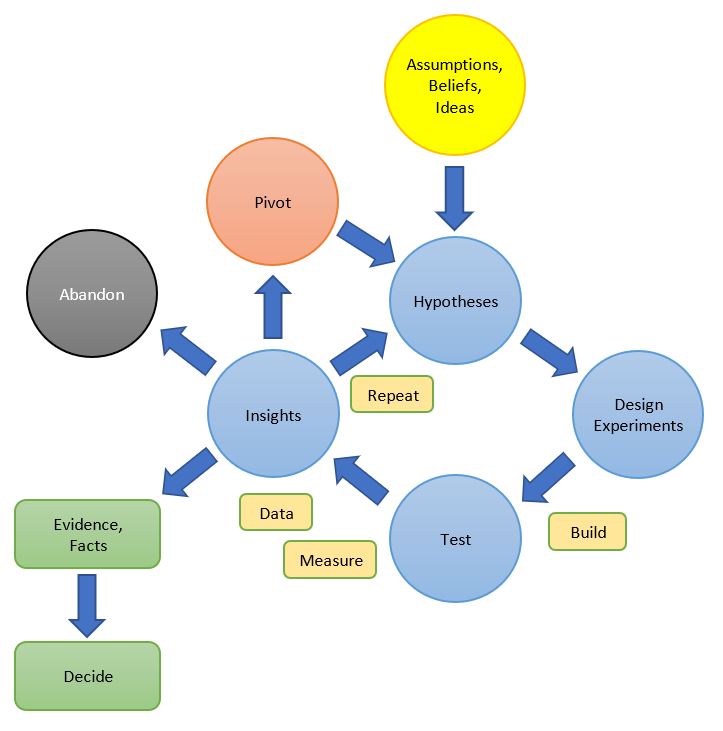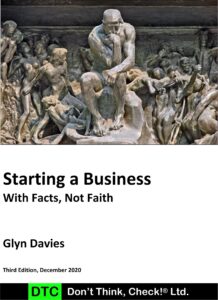

Introduction
At the core of good decision-making and what Don’t Think, Check!® uses is the scientific method, where:
- The scientific method is a set of principles, implemented in empirical processes to acquire knowledge. The specific steps in the processes can vary, but they typically feature, formulating falsifiable hypotheses, designing replicable experiments to validate or invalidate those hypotheses, conducting experiments and gathering observations and data with which to synthesise insights, and refinement, alteration, expansion, or rejection of hypotheses based on those insights. Wikipedia.
- The results of the scientific method are considered to be provisional; new information may come to light which may invalidate any hypothesis in whole or in part. When this happens, to paraphrase Daniel Kahneman, the true scientist is happy because it means that they are now less wrong than they once were.
One method to implement the scientific method is The Hypotheses, Design Experiments, Test, and Insights (HDETI) Process, Steve Blank.
The explicit goal for using The HDETI Process is to gather actionable evidence to be able to unambiguously and with high confidence make a decision. Where decisions, following the scientific method, are as far as practical, made on the basis of the available evidence and facts, and where evidence and facts are synthesised from Insights from experiments.
In the diagram above, you can see that the process has within it a loop (the blue circles) or repetitive cycle, starting with Hypotheses, moving to Design Experiments, and working its way back to Hypotheses again through Test and then Insights.
The Method Explained
Assumptions, Beliefs, and Ideas
The Application of the scientific method and every navigation of the loop starts with assumptions and or beliefs and or ideas.
To reduce the risk of waste, a decision-maker does not spontaneously start making decisions on the basis of assumptions, beliefs, or ideas. The astute decision-maker seeks out evidence and facts.
Hypotheses
The process cycle begins by acknowledging that assumptions, beliefs, and ideas are:
- Assumption – a thing that is accepted as true or as certain to happen, without proof.
- Belief – an acceptance that something exists or is true, especially one without proof.
- Idea – A thought or suggestion as to a possible course of action.
Oxford Dictionaries, emphasis added.
Committing to a course of action and investment on the basis of assumptions, beliefs, and ideas is gambling. Instead of gambling, falsifiable hypotheses are developed to be validated or invalidated with the results of experiments.
The concept and term falsifiable is critical. Falsifiable refers to the possibility of proving a hypothesis to be invalid. For example, the hypothesis that “all swans are white” can be invalidated if one black swan is found.
As insights are gathered with each circuit of the loop, hypotheses will likely be refined, altered, expanded, rejected, and new ones developed.
Design Experiments
Experiments are specifically designed to validate or invalidate each hypothesis, with particular attention paid to being able to obtain reproducible test results and gather meaningful data, from which insights can be synthesised.
Careful experimental design is needed to ensure that only the variables of interest are being evaluated and then, to avoid confounding results, that as few variables as possible are being evaluated at a time.
Reproducibility of experimental results is where independent researchers using the same experimental design and procedures under specified conditions will be able to produce similar or near-identical results.
Test
Within the test environment specified in the experiment design, tests are carefully conducted and meaningful results objectively gathered and recorded as data.
Insights
The goal of the experiments is not simply to collect data as such but to gather meaningful data to enable insights to be synthesised, that will inform the next steps in the process:
Repeat
There are many reasons to repeat the process:
- One or more hypotheses were more or less validated, and it is deemed worthwhile to continue investing to learn more with another circuit of the loop, with as the case may be refined or altered hypotheses.
- One or more hypotheses may have been invalidated, but insights have suggested new hypotheses.
With each circuit of the loop, the fidelity of the hypotheses and experimental design are increased to learn more.
Pivot
The project has invalidated the hypotheses (also see Abandon below), and or another opportunity with new hypotheses has been uncovered from the synthesised insights.
Based on the new hypotheses, a new circuit of the loop is initiated, and the process repeated.
Abandon
The project has invalidated the hypotheses and will be abandoned:
- The original concern or interest (the need?) is not so interesting or important that anyone wants to continue the investment in investigating.
- The projected costs of further investigation are too high and or rewards too small and or too uncertain to risk continuing exploration by starting another circuit of the loop.
- The resources and or enthusiasm to continue the project have been exhausted.
Evidence and Facts
The project has proven to be successful, meaning that hypotheses were validated, insights were synthesised into actionable evidence and actionable facts and there is little more to learn that warrants another circuit of the loop.
All that remains is deciding what to do based on the evidence and facts.
More Reading
To apply the scientific method and The HDETI Process to business, please see The Hypotheses, Design Experiments, Test, and Insights Process.



